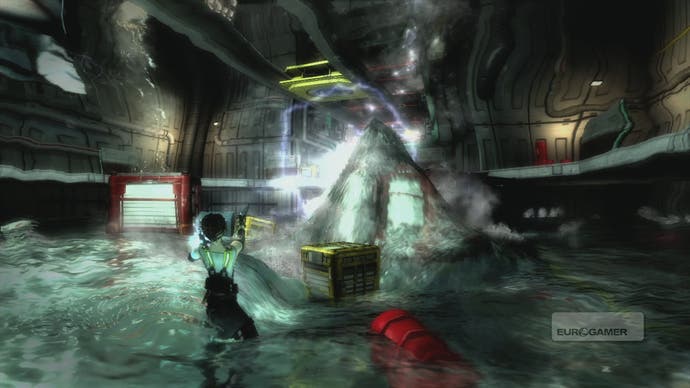Hydrophobia
Give us a wave.
Letting him die wouldn't have meant game-over though - different choices and paths of action cause the script and story to unfold in different ways, with or without some of the supporting cast. Later on we're given a chance to rescue a hostage by flooding the room and electrocuting his captors via a CCTV system - again, failure will mean a different script tree and less of the game's collectables littering the play area.
The MAVI becomes an extremely useful tool as the game progresses, helping Kate to navigate the labyrinthine corridors of the ship, and giving Dark Energy excellent scope for creative puzzles. It's a little like the visor Samus Aran has in Metroid, offering an augmented picture of reality as well as an interface to access various collectables and data files that Kate collects during her escape.
The flip side to this MAVI-based problem-solving is the combo-building combat. When Kate first finds a firearm, it only has sonic ammunition, great for stunning terrorists temporarily but not great for killing them. These rounds will shove oil barrels around though - or burst fuse-boxes, break glass and explode and ignite barrels.
Bursting a barrel creates a slick of oil on the water, great if the flow is heading away from you, but extremely dangerous if the tide turns. Making sure that a barrel is near an enemy can mean knocking it towards them with a few light shots, or simply waiting for one to float by. Alternatively you could shatter a window into a flooded room behind them, unleashing the water and washing them towards danger, or simply drowning them.
Electricity is equally effective, with the large, fizzing junction boxes handily highlighted by the aiming reticule when it passes over them. The power itself will arc out from the box once broken, searching for the nearest conductible material, including water. Use a combination of methods to kill an enemy and you'll get a much bigger multiplier and consequently a much bigger score, all adding to your published leaderboard position.
The physics modelling itself is excellent, although the water does seem a little viscous, presumably to make the most of the lovely, rolling flow when it enters a room. Originally the water physics were modelled even more accurately, with currents sweeping Kate off her feet more often, or pushing against her underwater, but these effects were toned down to reduce frustration.
Essentially, Hydrophobia is something of a shop window for the proprietary Hydro Engine and Infinite Worlds technology used to build the game. Dark Energy wants to show what it can do with the tools it's created in the hope they'll be taken up by others.

In order to make sure that its work is appreciated, the team has also included a challenge room mode, pitting Kate against waves of enemies to maximise her score before she's overcome. Kate has access to advanced nanotechnology in this mode, allowing her to manipulate the water itself into a column.
This column can then be moved around the challenge room, picking up enemies, crates, barrels and shipping containers. Innovative deaths mean higher scores, and a variety of different ammo types for Kate's pistol means that things can get pretty creative. For example, sticking an electricity-producing static round to a barrel before flinging it into a crowd of goons will see them all electrocuted, but chucking a crate covered in explosives in their direction first means it will all be followed up by a big bang too.
The variety of control options means that the button space gets a little crowded, and an unconventional approach to mapping them takes a little getting used to as well, but otherwise Hydrophobia already looks like a very polished product, full of neat touches and new ideas. Its combination of dark philosophy, high-score hunting and physical puzzling might not be to everyone's taste, but Dark Energy's ambition has made it worth keeping an eye on.
Hydrophobia is due out for PC, PlayStation Network and Xbox Live Arcade but will be a timed exclusive for the latter.
